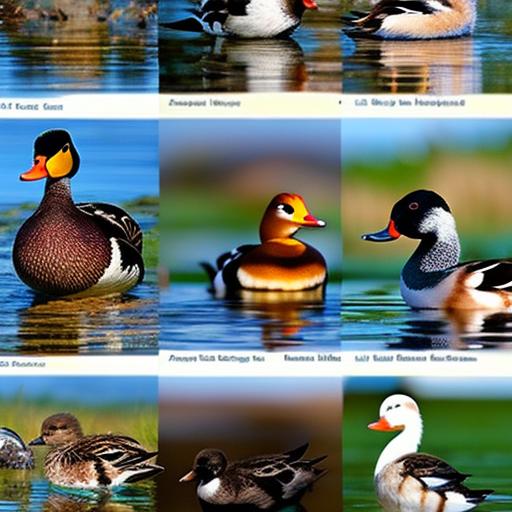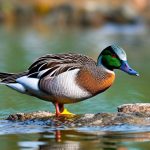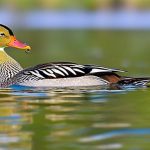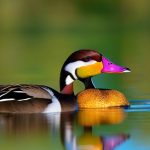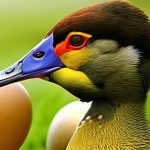Ducks are fascinating creatures that come in a variety of breeds, each with its own unique characteristics and appearances. Understanding the different duck breeds is important for several reasons. Firstly, it allows us to appreciate the diversity and beauty of these birds. Secondly, it helps us choose the right breed for our specific needs, whether it be for egg production, meat, or simply as pets. Lastly, understanding duck breeds can also aid in conservation efforts, as some breeds are endangered or at risk of extinction.
Key Takeaways
- There are many different breeds of ducks, each with their own unique characteristics and traits.
- The Mallard duck is a common breed with distinctive green heads and brown bodies.
- Pekin ducks are a popular breed for meat production and have white feathers and orange bills.
- Muscovy ducks are known for their unique appearance and friendly personalities.
- Runner ducks are athletic and adaptable, making them great for both egg production and pest control.
Mallard Duck Breed – Characteristics and Appearance
The Mallard duck is perhaps one of the most well-known and recognizable duck breeds. These ducks have a vibrant green head, a brownish-gray body, and a distinctive white neck ring. Mallards are medium-sized ducks, with males (drakes) being slightly larger than females (hens). They have a long, slender body and a pointed tail.
Mallards are highly adaptable birds and can be found in a wide range of habitats, from wetlands to urban parks. They are known for their ability to fly long distances and their distinctive quacking sound. Fun fact: Did you know that male Mallards have a unique feature called “drake feather curls”? These curls are formed during molting and give the drakes a stylish appearance.
Pekin Duck Breed – History and Physical Features
The Pekin duck breed has a rich history that dates back to ancient China. These ducks were originally bred for meat production and were highly prized for their tender and flavorful meat. Pekin ducks have a large, round body with white feathers and orange bills and feet.
Pekin ducks are known for their calm and friendly nature, making them popular as pets or farm animals. They are also excellent egg layers, producing large white eggs. In addition to their meat and egg production capabilities, Pekin ducks are often used in pest control, as they have a voracious appetite for insects and snails.
Muscovy Duck Breed – Unique Traits and Personality
Muscovy ducks are unique among duck breeds, as they are not true ducks but rather a separate species. They have a distinct appearance, with males having red or black wattles and caruncles on their face, and females having smaller wattles. Muscovy ducks come in a variety of colors, including black, white, and blue.
One of the most notable traits of Muscovy ducks is their ability to perch on trees. Unlike other duck breeds, Muscovies have strong claws that allow them to grip onto branches. They are also known for their calm and docile nature, making them popular as pets or for small-scale farming. Muscovy ducks are excellent foragers and can help control pests in gardens or farms.
Runner Duck Breed – Athleticism and Adaptability
Runner ducks are known for their unique upright posture and distinctive running gait. They have a slender body, long neck, and legs positioned towards the back of their body. This unique anatomy allows them to run rather than waddle like other duck breeds.
Runner ducks are highly athletic birds and are known for their ability to run at high speeds. They are also excellent foragers and can adapt to a variety of environments. Fun fact: Runner ducks have been used in rice fields in Asia for centuries, where they help control pests while not damaging the crops.
Rouen Duck Breed – Coloration and Size
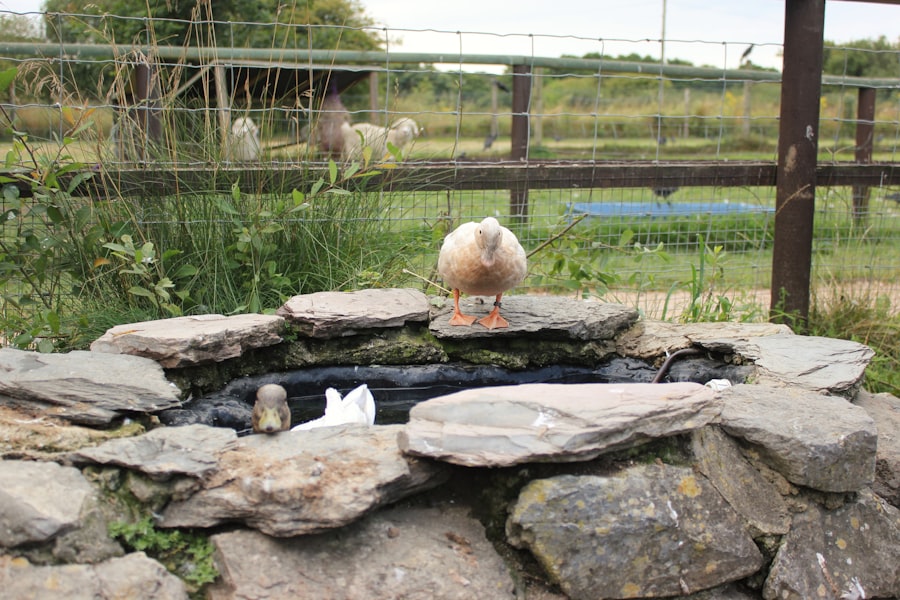
Rouen ducks are large, heavy-bodied birds with striking coloration. They have a dark green head, a deep chestnut-colored body, and white markings on their wings. Rouens are similar in appearance to Mallards but are larger in size.
Rouen ducks were originally bred in France for meat production but are now primarily kept as ornamental birds. They are known for their calm and gentle nature, making them popular as pets or for exhibition purposes. Rouen ducks are also good egg layers, producing large white or tinted eggs.
Khaki Campbell Duck Breed – Egg Laying and Temperament
Khaki Campbell ducks are a breed that was developed in England in the late 19th century. They have a khaki-colored plumage, with males having a slightly darker shade than females. Khaki Campbells are medium-sized ducks with a slender body and a long neck.
One of the main reasons why Khaki Campbell ducks are popular is their exceptional egg-laying ability. They are known to lay up to 300 eggs per year, making them one of the most productive duck breeds in terms of egg production. Khaki Campbells are also known for their friendly and sociable nature, making them great pets or farm animals.
Indian Runner Duck Breed – Quirky Appearance and Behavior
Indian Runner ducks are perhaps one of the most unique-looking duck breeds. They have an upright posture, long neck, and slender body. Indian Runners come in a variety of colors, including white, fawn, and black.
What sets Indian Runner ducks apart is their quirky behavior. They have a distinctive running gait and can often be seen running rather than walking. Indian Runners are highly active birds and require plenty of space to roam and exercise. Fun fact: Indian Runner ducks have been nicknamed the “penguin ducks” due to their upright posture and waddling gait.
Welsh Harlequin Duck Breed – Conservation and Popularity
The Welsh Harlequin duck breed is relatively new, having been developed in Wales in the early 20th century. These ducks have a beautiful plumage, with males having a silver head and neck and females having a silver-brown coloration. Welsh Harlequins are medium-sized ducks with a compact body and a slightly upright posture.
The Welsh Harlequin breed has gained popularity in recent years due to its attractive appearance and excellent egg-laying ability. They are known to lay up to 300 eggs per year, making them a highly productive breed for egg production. However, despite their popularity, Welsh Harlequins are considered a rare breed and efforts are being made to conserve and promote their genetic diversity.
Cayuga Duck Breed – Color Changing Feathers and Utility Purposes
Cayuga ducks are known for their unique color-changing feathers. When they hatch, Cayuga ducklings have black feathers, but as they mature, their feathers gradually change to a beautiful iridescent green-black color. This coloration makes them highly sought after for ornamental purposes.
Cayuga ducks are medium-sized birds with a compact body and a slightly upright posture. They are known for their calm and friendly nature, making them popular as pets or for small-scale farming. Cayugas are also good egg layers, producing large dark-colored eggs. In addition to their ornamental and egg-laying qualities, Cayuga ducks are also valued for their meat, which is flavorful and tender.
Duck breeds come in a wide variety of shapes, sizes, and colors, each with its own unique characteristics and uses. From the iconic Mallard to the quirky Indian Runner, each breed has its own charm and appeal. Understanding the different duck breeds not only allows us to appreciate their beauty but also helps us choose the right breed for our specific needs, whether it be for egg production, meat, or simply as pets.
So next time you see a duck waddling by or swimming gracefully in a pond, take a moment to appreciate the diversity of duck breeds and the important roles they play in our lives. And remember, when it comes to ducks, there’s always something new to learn and discover. As the saying goes, “Quack yourself up with duck knowledge!” Quack yourself up with duck knowledge! From the familiar Mallard to the exotic Mandarin, ducks come in a wide array of colors, sizes, and behaviors. Each breed has its own unique characteristics and adaptations that make them well-suited for different environments and purposes. Some ducks, like the Pekin, are bred for their meat and eggs, providing sustenance for many people around the world. Others, such as the Muscovy, are valued for their pest control abilities, as they eat insects and small rodents. Additionally, ducks play a crucial role in maintaining wetland ecosystems by dispersing seeds and controlling aquatic vegetation. They are also a source of inspiration for artists and writers, symbolizing grace, resilience, and adaptability. So let’s celebrate these fascinating creatures and continue to explore the wonders of the duck world!
If you’re interested in learning more about different duck breeds, you might also find this article on poultrywizard.com helpful. It provides valuable information and pictures of various duck breeds, allowing you to explore the unique characteristics and appearances of each breed. Check it out here to discover more about these fascinating waterfowl.
FAQs
What are duck breeds?
Duck breeds refer to the different types of ducks that exist, each with unique physical and behavioral characteristics.
How many duck breeds are there?
There are over 100 different duck breeds recognized worldwide.
What are some common duck breeds?
Some common duck breeds include the Pekin, Mallard, Muscovy, Rouen, and Khaki Campbell.
What are the differences between duck breeds?
Duck breeds differ in size, color, feather patterns, behavior, and egg-laying abilities.
What are some uses for duck breeds?
Duck breeds are used for meat, eggs, feathers, and as pets or for ornamental purposes.
What are some interesting facts about duck breeds?
Ducks have waterproof feathers, can fly up to 60 miles per hour, and have a unique gland that produces oil to keep their feathers waterproof. Some duck breeds, like the Muscovy, are known for their ability to control pests like mosquitoes and flies.
Meet Walter, the feathered-friend fanatic of Florida! Nestled in the sunshine state, Walter struts through life with his feathered companions, clucking his way to happiness. With a coop that’s fancier than a five-star hotel, he’s the Don Juan of the chicken world. When he’s not teaching his hens to do the cha-cha, you’ll find him in a heated debate with his prized rooster, Sir Clucks-a-Lot. Walter’s poultry passion is no yolk; he’s the sunny-side-up guy you never knew you needed in your flock of friends!

